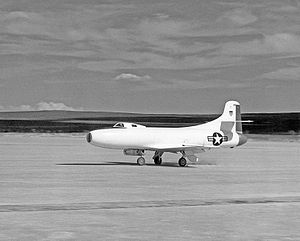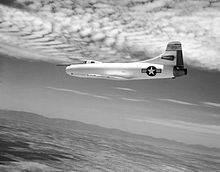- Douglas D-558-1 Skystreak
-
The United States Douglas Skystreak (D-558-1 or D-558-I) was a single-engine jet research aircraft of the 1940s. It was designed in 1945 by the Douglas Aircraft Company for the U.S. Navy Bureau of Aeronautics, in conjunction with the National Advisory Committee for Aeronautics (NACA). The Skystreaks were turbojet-powered aircraft that took off from the ground under their own power and had unswept flying surfaces.
Contents
Development
The D558 program was conceived as a joint NACA/U.S. Navy research program for transonic and supersonic flight. As originally envisioned, there would be three phases to the D558 program: a jet-powered airplane, a mixed rocket/jet-powered configuration, and a design and mockup of a combat aircraft.[1] A contract for design and construction of six D558-1 aircraft for the first phase was issued on June 22, 1945. The original plan had been for six aircraft with a mixture of nose and side inlets and varying wing airfoil sections. That plan was quickly reduced to three aircraft of a single configuration with a nose inlet. Plans for the second phase with mixed rocket/jet propulsion were also dropped. Instead, a new aircraft, the D558-2, was designed with mixed rocket and jet propulsion for supersonic flight.
Construction of the first 558-1 began in 1946 and was completed in January 1947. The fuselage used magnesium alloys extensively, while the wings were fabricated from more conventional aluminum alloys. The airframe was designed to withstand unusually high loads of up to 18 times gravity due to the uncertainties of transonic flight. The forward fuselage was designed so that it, including the cockpit, could be jettisoned from the aircraft in an emergency.[2] The aircraft was configured to carry more than 500 lb of test equipment, including sensors (primarily strain gauges and accelerometers) in 400 locations throughout the aircraft. One wing was pierced by 400 small holes to enable aerodynamic pressure data to be collected.[3]
The Skystreaks were powered by one Allison J-35-A-11 engine (developed by General Electric as the TG-180) and carried 230 US gallons (871 l) of aviation fuel (kerosene).
Operational history
All the Skystreaks were initially painted scarlet, which led to the nickname "crimson test tube." NACA later had the color of the Skystreaks changed to white to improve optical tracking and photography. The first of three D-558-1 Skystreaks, BuNo 37970, made its maiden flight on April 14, 1947, at Muroc Army Air Field (later named Edwards AFB). Less than 4 months later, on August 20, this aircraft with Commander Turner Caldwell, USN, set a new world speed record of 641 miles per hour (1,032 km/h) flying D-558-1 #1, the very first air speed record that exceeded the unofficial mark of 1004 km/h (623.8 mph) set by an example of the World War II-era German Messerschmitt Me 163 Komet rocket fighter prototype, itself set in very early October 1941. The D-558-1 #1 Skystreak's record lasted 5 days, and was broken by Marine pilot Marion Carl going 10 miles per hour (16 km/h) faster in D-558-1 #2, BuNo 37971. This aircraft was delivered to the NACA Muroc Flight Test Unit in April 1949 after 101 flights had been completed by the Navy, Air Force, and Douglas. This aircraft was never flown by the NACA. The D-558-1 #1 is located at the National Museum of Naval Aviation at Naval Air Station Pensacola, Florida.
Following 27 flights by the Navy and Douglas the second D-558-1 aircraft was delivered to the NACA in November 1947. The D-558-1 #2 underwent extensive instrumentation by the NACA Muroc instrumentation section. The number 2 Skystreak made a total of 19 flights with the NACA before it crashed on takeoff due to compressor disintegration on May 3, 1948, killing NACA pilot Howard C. Lilly. The third D-558-I, BuNo 37972, aircraft was delivered to the NACA Muroc Flight Test Unit in 1949 after three Douglas test pilots and Howard Lilly had flown it. The number three aircraft took over the planned flight program of the D-558-1 #2. From the first flight in 1949 through 1953 the third Skystreak was flown in an intensive flight-research program by seven NACA test pilots, with a great deal of useful data collected on high-subsonic handling. The D-558-1 #3 made a total of 78 research flights with the NACA before being retired on June 10, 1953. The third Skystreak is on display at Carolinas Aviation Museum located at the Charlotte-Douglas International Airport (CLT) in Charlotte, North Carolina.
The Skystreak reached Mach 0.99 in level flight, but only flew supersonic in a dive.[3] In the public mind, much of the research performed by the D-558-1 Skystreaks was quickly overshadowed by Chuck Yeager and the supersonic X-1 rocket plane. However, the Skystreak performed an important role in aeronautical research by flying for extended periods of time at transonic speeds, which freed the X-1 to fly for limited periods at supersonic speeds.
Aircraft serial numbers
- D-558-1 Skystreak
- D-558-1 #1 - BuNo 37970 NACA-140, 101 flights
- D-558-1 #2 - BuNo 37971 NACA-141, 46 flights
- D-558-1 #3 - BuNo 37972 NACA-142, 81 flights
- D-558-1 #4, #5, #6 Additional aircraft originally ordered but later cancelled.
Specifications (D-558-1 Skystreak)
General characteristics
- Crew: one pilot
- Payload: 500 lb of instruments (227 kg)
- Length: 35 ft 8 in (10.87 m)
- Wingspan: 25 ft 0 in (7.62 m)
- Height: 12 ft 1 in (3.68 m)
- Wing area: 150.7 ft² (14.00 m²)
- Loaded weight: 9,750 lb (4,423 kg)
- Max takeoff weight: 10,105 lb (4,583 kg)
- Powerplant: 1 × Allison J35-A-11 turbojet, 5,000 lbf (22 kN)
Performance
- Maximum speed: 650 mph at sea level (1,050 km/h)
- Stall speed: 137 mph (221 km/h)
- Service ceiling: 45,700 ft (13,900 m)
- Rate of climb: 9,220 ft/min (2,810 m/min)
- Wing loading: 67 lb/ft² (330 kg/m²)
- Thrust/weight: 0.51
See also
- Related development
- Aircraft of comparable role, configuration and era
- Related lists
References
- ^ Francillon, René J. (1988). McDonnell Douglas Aircraft Since 1920: Volume I. Annapolis, MD: Naval Institute Press. ISBN 0-87021-428-4.
- ^ "Skystreaks Heads For The Speed Limit" , March 1947, Popular Science illustration bottom of page 95
- ^ a b Heinemann, Edward H.; Rosario Rausa (1980). Ed Heinemann: Combat Aircraft Designer. Annapolis, MD: Naval Institute Press. ISBN 0-87021-797-6.
External links
- Towards Mach 2: The Douglas D-558 Program. NASA History Series 1999. PDF
- "Skystreaks Heads For The Speed Limit" , March 1947, Popular Science pages 94 and 95 (pages are not in sequence order, scroll ten pages downward to see page 95)
Douglas military aircraft Fighters Ground attack Naval bombers
and attack aircraftBombers Observation Patrol PD · P2D · P3D
Reconnaisance Transports C-1 · C-21 · C-32 · C-33 · YC-34 · C-38 · C-39 · C-41 · C-41A · C-42 · C-47 · C-48 · C-49 · C-50 · C-51 · C-52 · C-53 · C-54 · C-58 · UC-67 · C-68 · C-74 · C-84 · C-110 · XC-112/YC-112 · XC-114 · YC-116 · C-117 · C-118 · C-124 · YC-129 · C-133 · XCG-17
C-9 · C-24
RD · R2D · R3D · R4D (R4D-2 & R4D-4) · R5D · JD · R6D
CC-129 · Dakota I/III/IV · Dakota II · LXD1 · PD.808 · Skymaster ITraining aircraft Experimental USAF/Joint Service experimental aircraft designations 1941– (X-planes) 1–25 26–50 50- X-51 · (X-52 not assigned) · X-53 · X-54 · X-55
Lists relating to aviation General Aircraft (manufacturers) · Aircraft engines (manufacturers) · Airlines (defunct) · Airports · Civil authorities · Museums · Registration prefixes · Rotorcraft (manufacturers) · TimelineMilitary Accidents/incidents Records Categories:- Douglas aircraft
- United States experimental aircraft 1940–1949
- D-558-1 Skystreak
Wikimedia Foundation. 2010.


